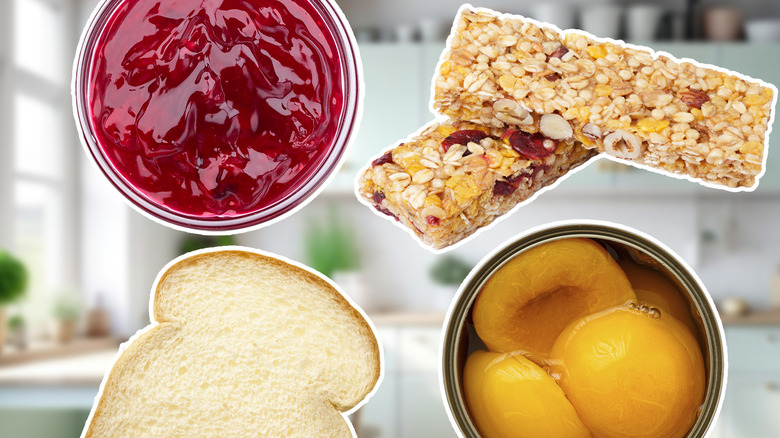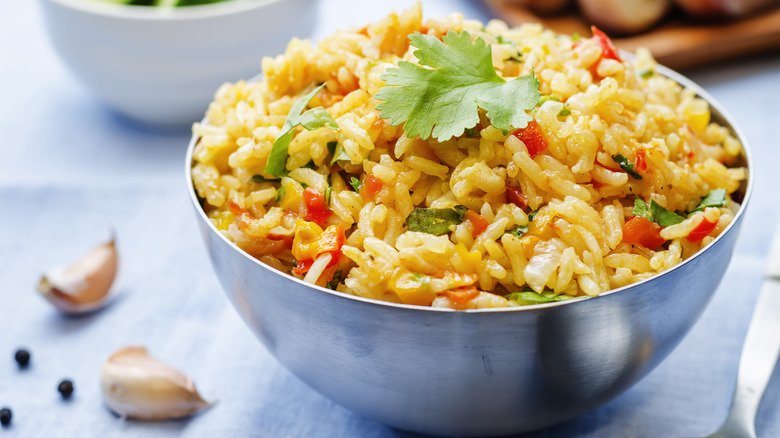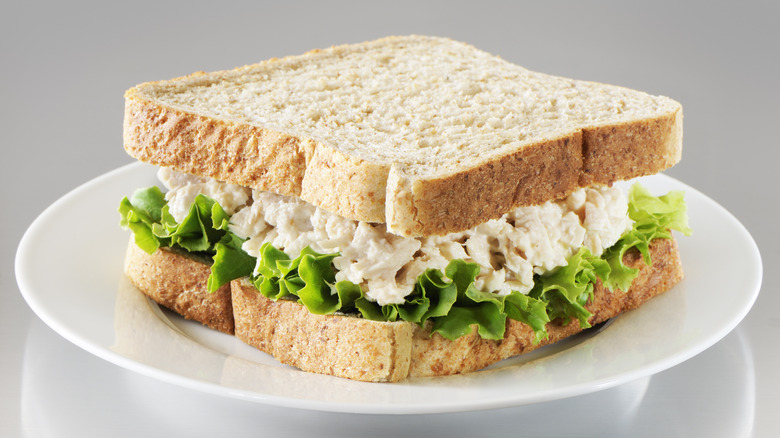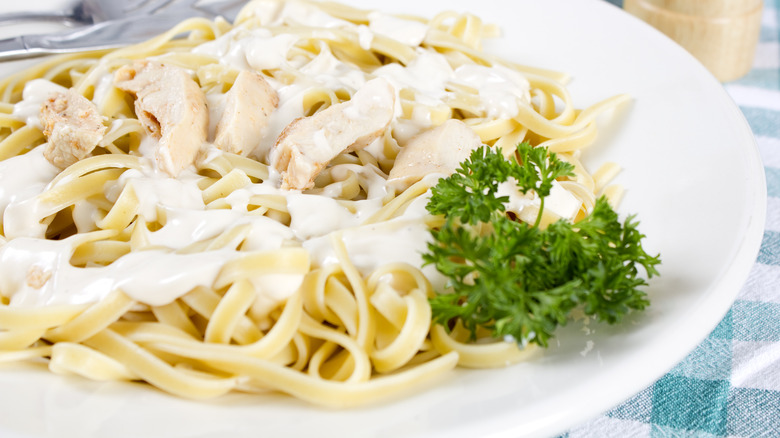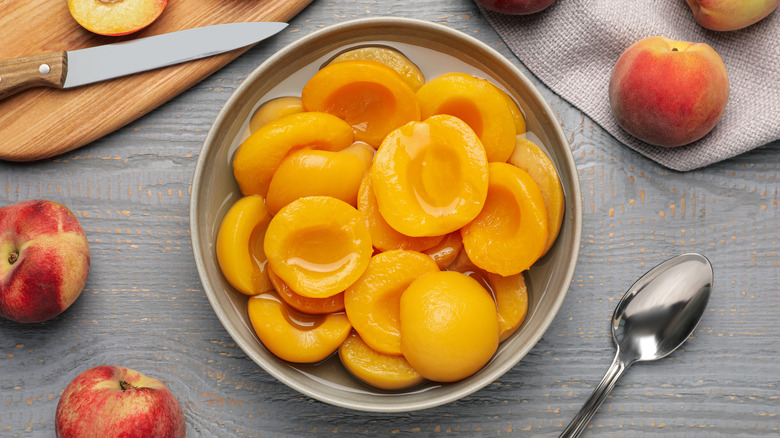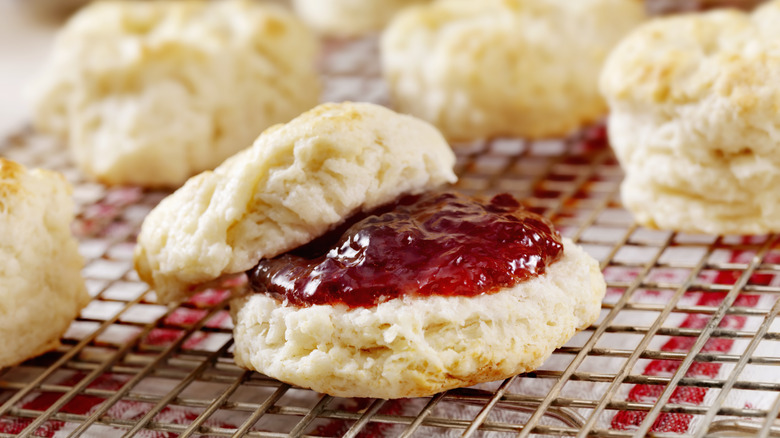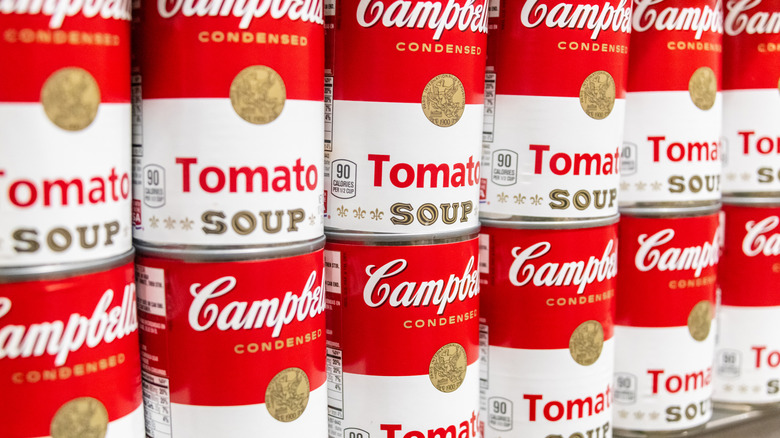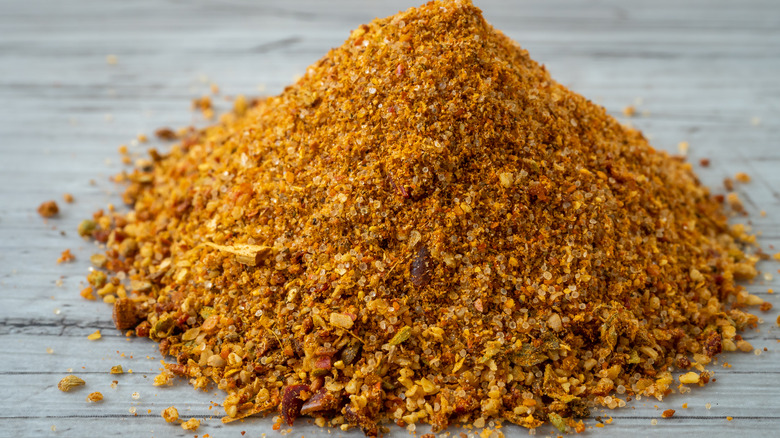Unsuspecting Pantry Staples That Are Secretly Unhealthy
Pantry staples are typically thought of as your normal run-of-the-mill grocery items, most of which may seem relatively healthy. Many of these foods have become a part of the standard American diet, but what if there was more to your typical pantry staple than what meets the eye? Sure, we know that packaged cookies and sodas deliver a one-two punch to our systems in terms of health, but what about some of the more unsuspecting pantry grabs? Are they any better?
In today's post, we'll attempt to answer that question. Though many pantry items are fine to consume, there are some that contain ingredients and nutrition facts you may not know about. Additives, fat, sodium, and added sugars all deserve a second glance before getting added to your diet and should typically be consumed in moderation. Let's take a closer look at the unsuspecting pantry staples that may prove to be secretly unhealthy.
Granola bars and breakfast bars
You'd think granola bars and breakfast bars would be healthy. After all, they aren't quite like cookies, packed full of butter and sugar, right? Well ... that depends. While there are plenty of healthier granola and breakfast bars out there, there are also a ton of bars impersonating a healthy snack when, in actuality, they are anything but.
Chewy granola bars and breakfast bars with fruit filling are great examples of this. If you look closely, you'll see that added sugar, preservatives, artificial flavors, and more fill the ingredient list. Don't believe us? Quaker Chewy granola bars come with about 7 grams of added sugar per bar. For reference, you'd get roughly the same amount of sugar by eating two Chips Ahoy cookies. Kroger brand chewy granola bars are even worse concerning ingredients, with preservatives and artificial flavors stuffed inside.
As far as breakfast bars go, fruit-filled "wholesome" options like Nutri-Grain bars actually contain 12 grams of added sugar, which, if we go back to our Chips Ahoy comparison, is more sugar than you'd get by eating three Chips Ahoy cookies! It doesn't sound like Nutri-Grain bars and other bars like them are so "nutritious," after all. Do what you want, but these snacks might not be the healthy grabs they seem to be.
Packaged rice
If you ask us, rice ought to just be rice. Unfortunately, there are brands out there that sport more than just the simple grain and contain strange additives that may make the rice taste good, but may not result in a very healthy side dish to your main entrée.
Products like Rice-a-Roni are notorious for adding certain ingredients to rice that wouldn't normally be there. While cooking your own rice in a bit of stock with butter and seasoning is an easy and wholesome option, Rice-a-Roni prompts you to choose convenience over health. Expect Rice-a-Roni "Chicken" and "Mexican Style" flavors to contain ingredients like monosodium glutamate, known to cause headaches and sweating in sensitive individuals, hydrolyzed soy protein, known to cause allergic reactions and nausea, disodium guanylate, known to be unsafe for people with kidney stones and gout, and more. Will all of these additives make you keel over if you eat them? Probably not. The point is that these additives wouldn't normally be included in your average homemade rice recipe, and some additives you consume may prove risky to your health.
Oh, and one more thing. We want you to know that though products like Rice-a-Roni technically contain rice, they also oftentimes contain wheat. Why? We aren't sure, but for those of you who may be living with Celiac disease or following a gluten-free lifestyle, it's worth mentioning.
Canned meats
When it comes to canned meats, some options are better than others. For example, plain tuna and chicken breast are options that may be lean and yummy, but please be aware of the sodium content in each can. While some of you out there may be content eating only one can of tuna, others may eat multiple cans a day. If that sounds like you, it might be wise to begin monitoring your sodium intake, as these canned meats tend to be extremely high in sodium.
Your average can of tuna typically contains about 14% of your daily value of sodium, but eating two to three cans of it — or more — per day adds up quickly. In addition, canned chicken breast, namely the kind sold at Walmart under the Great Value brand, contains up to 29% of your daily value per can, so you can imagine how enjoying two to three cans would pose a problem. Remember that high sodium levels often contribute to heart disease, stroke, and high blood pressure, so monitoring the amount you take in daily is important.
Instant oatmeal
Okay, this one is a real bummer because we absolutely adore fruity-flavored instant oatmeal. It tastes so deliciously comforting to those of us who grew up with the stuff but, sadly, it isn't the greatest in terms of sugar content.
If you've ever picked up a box of flavored Quaker instant oats, you already know that the serving size is quite small. Just one of those little pouches is scant enough for an adult, making two (or three) packs of the stuff more realistic for one person. Unfortunately, each pack contains roughly 8-9 grams of sugar, depending on the variety you pick. Eating two to three packs then means you'll be looking at eating anywhere between 14-24 grams of sugar for breakfast. Yuck.
Instant oatmeal aimed at kids is even worse. Though fun to look at and eat, Quaker Dinosaur Eggs Brown Sugar oatmeal has 11 grams of sugar per packet, meaning your child will ingest at least that much during their morning meal. Seeing as how the American Heart Association recommends that most people are recommended to only consume 25-36 grams of sugar per day, starting your day out with high numbers like these won't do your health any favors.
Jarred pasta sauces
Most jarred pasta sauce brand varieties don't tend to be too bad healthwise as long as the sauce is red and tomatoey. Once you veer into white and creamy territory, however, expect to enter into the land of fat, calories, sodium, and additives. Oh, and can we talk about the serving sizes? Not sure about you, but we're inclined to believe that pasta is in need of more than just ¼ cup of sauce per single serving. Add to that the fact that some sauces, like Rao's Homemade Alfredo Sauce, pack 9 grams of fat, 6 grams of saturated fat, and 100 calories in that tiny portion, and you can see why jarred sauces like this make the unhealthy list.
And lest you think your standard tomato sauce is totally off the hook, allow us to inform you that although most tomato-based sauces fare quite well in terms of fat and calories, we did notice that some varieties within brands, such as the Ragú "kettle-cooked" sort, feature an elevated amount of fat. This pasta sauce checks in at 6 grams of fat per ½ cup, which isn't bad but still seems like a lot, given that other sauces within the same brand feature only 2 grams of fat per same serving size. All in all, just know that if it's fat content you're watching, then some jarred pasta types and brands are better than others, so be sure to choose wisely.
Bread
Bread may not be the first thing you think of when considering unhealthy pantry staples, and while not all loaves prove bad news, there are some that contain ingredients that may damage your health over time. According to Healthline, bleached flour found in white bread has been treated with certain chemicals like potassium bromate and benzoyl peroxide whose safety in regards to kidney damage, cancer, and other health risks has been brought into question. Other common bread additives known as monoglycerides have been linked to an increased risk of stroke when consumed in large amounts due to the presence of trans fats. And in case you think buying wheat bread instead of white makes things better, you'll be interested to know that even some 100% whole wheat breads contain some of these threatening additives, making it tough to select a loaf that's right.
So, which grocery store breads are worthwhile? That depends on what you're looking for. Through our extensive research, we aren't sure we've run across any store-bought bread that doesn't at least have some form of preservative, dough conditioner, or bleached flour in the mix. That isn't to say you'll find every additive in every brand, but rather you'll likely find at least one of these offenders no matter which brand you buy. Ultimately, whether or not you consume store-bought bread is up to you, we're just here to help you stay informed along the way.
Canned fruit
Canned fruit should be a healthy and nutritious addition to your pantry, but, as it turns out, it can be one of the most sugary things you put into your shopping cart. Let's be clear here — the fruit itself isn't unhealthy. It's the stuff that the fruit is doused in that's the concern.
When purchasing canned fruit for the cupboard, make sure you take a close look at the label. Fruit labeled as containing "heavy syrup" or even "light syrup" means you can expect added sugar in the can and, in most cases, a heaping dose of high fructose corn syrup, too. In case you aren't aware, high fructose corn syrup has been shown to lead to obesity, an increase in appetite, fatty liver disease, and inflammation. And while it tastes nice, we think the use of high fructose corn syrup over fruit is particularly egregious given that fruit is perfectly sweet on its own.
By the way, the serving size for cans of fruit featuring heavy or light syrup are typically very small, at only half a cup per serving. In Del Monte Yellow Cling Sliced Peaches, expect to end up with 17 grams of added sugar in that meager portion, which is pretty outrageous if you think about it. Instead of buying cans of fruit in syrup, consider purchasing varieties labeled as "in juice" instead. These usually contain no added sugars and may fare better for your health as a result.
Healthy cereals
Healthy cereals are out there, but when it comes to sweetened cereal, the word "healthy" is usually a bit of a misnomer. Cereals like Cascadian Farms and Special K are often touted as healthier cereal grabs, but in reality, they often contain just as much added sugar as your typical kid-friendly cereal bowl.
Need proof? If you take a look at Special K with Red Berries variety, you'll see that a cup of cereal rings in at 10 grams of added sugar. Cinnamon Toast Crunch has 12 grams, meaning you'll only save yourself 2 grams of sugar by opting for the "healthier" stuff. In the same vein, Kellogg's Mini Wheaties has 12 grams per cup, and Cascadian Farms Cinnamon Crunch Breakfast cereal has 11 grams per cup. Guess it goes to show how much it pays off to read the label. Healthy might not mean what you think it does when you take the time to compare.
Jellies and jams
Love smearing jelly on toast? Don't we all? The fruity goodness comes wonderfully flavored, but with that flavor typically comes quite a bit of sugar. And not just any sugar — but high fructose corn syrup at that. We've already broken down the scary ramifications of consuming too much high fructose corn syrup, so we won't rehash that here. Just know that your typical jam or jelly will contain the stuff, and just because you use a little bit of it doesn't mean you're off the hook. Actually, only a single tablespoon of Smucker's Squeeze Grape Jelly contains a whopping 9 grams of added sugar! Indulge in more than that, and you're up the creek in terms of sugar content.
Having said that, there are some jam and jelly varieties out there that are a bit better than your average grab. Look for Smucker's Simply Fruit to ditch the high fructose corn syrup ( it's still high in added sugar, though), or give St. Dalfour jelly a try if you're craving something sweet yet without table sugar. These better-for-you jelly options might cost you a bit extra, but it might be worth it, especially if you're a jelly and jam fan.
Flavored nut butters
Flavored nut butters can spell trouble when it comes to added sugar, but first, let's distinguish between flavored nut butters and other kinds. Regular nut butters like almond butter, peanut butter, and others tend to be low in sugar, if they contain any sugar at all. Flavored nut butters, on the other hand, can contain a significant amount of added sugar, depending on the brand.
Simple Truth Honey Almond Butter, for example, contains 4 grams of added sugar per 2 tablespoons compared to Simple Truth Almond Butter original, which contains 1 gram of added sugar. Not convinced of the unhealthy difference? Let's take a look at nutrition facts for Nutella. This hazelnut spread has indeed become one of America's favorites, but when it comes to how much added sugar is in the stuff, we have to say, we're shocked. There are 19 grams — yes, 19 grams — of added sugar in only 2 tablespoons of this, albeit delicious, hazelnut spread. Considering the fact that you should only consume around 25-36 grams of sugar per day per the American Heart Association, we think the nutrition facts on some flavored nut butters are something you ought to be aware of.
Soup
You may be surprised to see soup on the list, but it's definitely a pantry staple you'll want to look out for. Sodium tends to be the main offender when it comes to canned soup, but be on the lookout for other potentially harmful additives, like monosodium glutamate, as well.
So, what soup brands out there might you need to approach with caution? Most of them tend to be higher in sodium, but some are worse than others. Out of the soups we've examined, we've noticed that flavors like Campbell's New England Clam Chowder have monosodium glutamate known to cause headaches, weakness, and sweating in sensitive individuals. It also has enough sodium per can to make up nearly 75% of your daily value at 1720 mg. Other ingredients like disodium guanylate add to sodium content amounts and can also cause adverse effects in people with kidney stones, gout, or those who are sensitive to monosodium glutamate. Other brands like Progresso aren't much better, with some flavors featuring sodium amounts of 1660 mg per can. We know eating a can of soup isn't the worst possible thing for your health, but it's definitely something you'll want to watch for in terms of sodium and additives — especially when consumed long-term.
Seasoning packets
Seasoning your own food can be a daunting task. After all, you have to get the ratio of salt, pepper, and other spices just right, and unless you really know what you're doing, using seasoning packets can be way easier to achieve the flavor you're looking for. We get it. Still, you may want to know that there are certain ingredients that come in seasoning packets that wouldn't be there if you were to spice up your meals yourself.
While your typical seasoning blend made at home may contain a bit of salt, pepper, granulated garlic, and other spices, seasoning packets, like Taco Bell's Mild Taco Seasoning Mix, will typically contain anti-caking agents, soy, and maltodextrin. And though these ingredients may only make up 2% or less of the seasoning, it's worth noting that some ingredients, like the maltodextrin we mentioned earlier, may have health consequences associated with them. Maltodextrin causes inflammatory bowel disorder and can also negatively impact your intestines. Other seasoning packets, like Hidden Valley Ranch Lemon Pepper Ranch Mix, contain dextrose, which is said to aggravate depression in certain individuals and trigger acne in others, per WebMD. Using packet seasonings in your dishes isn't exactly a recipe for disaster, but you might raise an eyebrow (or two) at some of the ingredients listed on the back.
Methodology
Unsuspecting pantry staples that are secretly unhealthy were devised by scanning ingredients on common pantry items with an emphasis on fat, added sugar, sodium, and harmful additives when present. While not all the ingredients and nutrition facts mentioned here render a death sentence to those consuming them, the facts we've provided are simply for your own information; ultimately, what you choose to consume or not to consume is up to you. We hope this helps!
